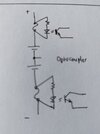I can not wrap my head around circuit designing, it's highly annoying!
Could please someone help me to design the circuit I'm looking for?
And please I'm looking for a circuit not other solutions like microcontroller LED across fuse, etc.
So my issue:
I have 6 leaf modules in parallel 8.4v when fully charged. That means that each cell is 4.2 V and I want to fuse each cell, the center pin is connected in parallel across all 6 modules that means I need a circuit for the negative terminal sensing and a circuit for the positive terminal sensing. It's a part of a large bank so the currents is max 25 A for each module (each fuse is 25 A).
I already found part of what I'm looking for here from this post.
but i think a voltage difference sensing circuit could work as well.
the circuit should also latch the outputs for the led and transistors just to make sure there is no intermitted faults passing by, and a reset switch to reset the latching
I have 384 fuses and 32 banks of 6 modules so that's why I'm looking for a circuit I can use for each of the parallel banks and wire it up to the Siemens PLC, no addressing required as the LED will show what fuse is blown.

Could please someone help me to design the circuit I'm looking for?
And please I'm looking for a circuit not other solutions like microcontroller LED across fuse, etc.
So my issue:
I have 6 leaf modules in parallel 8.4v when fully charged. That means that each cell is 4.2 V and I want to fuse each cell, the center pin is connected in parallel across all 6 modules that means I need a circuit for the negative terminal sensing and a circuit for the positive terminal sensing. It's a part of a large bank so the currents is max 25 A for each module (each fuse is 25 A).
I already found part of what I'm looking for here from this post.
but i think a voltage difference sensing circuit could work as well.
the circuit should also latch the outputs for the led and transistors just to make sure there is no intermitted faults passing by, and a reset switch to reset the latching
I have 384 fuses and 32 banks of 6 modules so that's why I'm looking for a circuit I can use for each of the parallel banks and wire it up to the Siemens PLC, no addressing required as the LED will show what fuse is blown.


